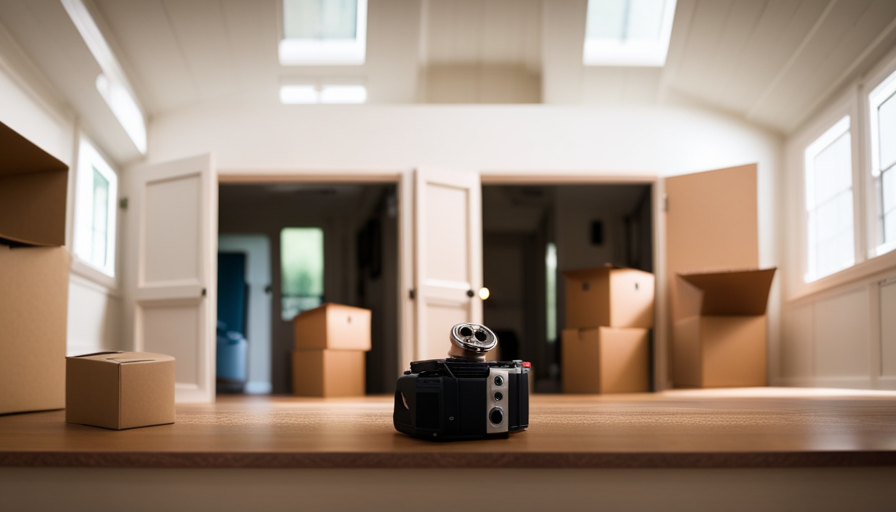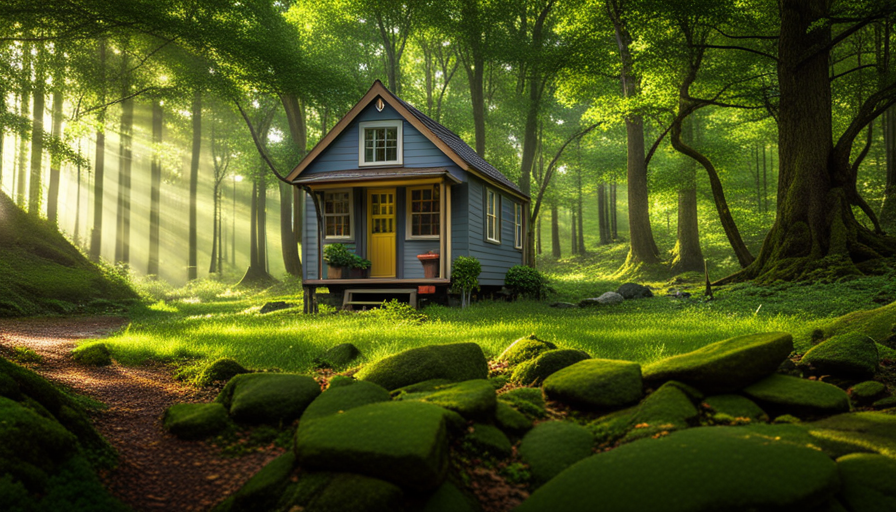Have you ever been curious about the fate of Tony and Lori after their appearance on ‘Tiny House Nation’? Following their adventure on the series, their path in life shifted unexpectedly. Within this article, we delve into the obstacles they faced, their personal evolutions, and what they envision for their future after transitioning to a smaller living space.
Tony and Lori faced numerous challenges during and after the show, from adjusting to minimalism to maintaining a minimalist lifestyle. They learned valuable lessons about the importance of simplicity and the impact it can have on their relationship. Through this experience, they discovered a newfound passion for pursuing their dreams and living life on their terms.
Join us as we delve into the details of Tony and Lori’s journey, from the ups and downs of tiny house living to their future goals. You’ll be inspired by their determination and resilience, and perhaps find inspiration to simplify your own life along the way.
Stay tuned to find out where Tony and Lori are now, and how their tiny house adventure has shaped their lives.
Key Takeaways
- Tony and Lori faced challenges adjusting to minimalism and maintaining a minimalist lifestyle after ‘Tiny House Nation’.
- They learned the importance of simplicity and how it can positively impact their relationship.
- Tony and Lori downsized to a tiny home and made clever use of space with multipurpose furniture and hidden storage compartments.
- Living in a tiny home allowed them to prioritize experiences over material possessions and have more financial freedom.
Tony and Lori’s Journey on ‘Tiny House Nation’
Now, let’s take a look at where I am now on my incredible journey with ‘Tiny House Nation’!
One of my favorite features of our tiny house is the clever use of space. We have multipurpose furniture, hidden storage compartments, and a loft bedroom that maximizes every inch. It’s amazing how much functionality we were able to squeeze into such a small space.
Another favorite feature is the sustainability aspect. Our tiny house is energy-efficient, with solar panels providing power and a rainwater collection system for gardening. Living in a tiny house has taught us a lot about successful tiny house living. We’ve learned to prioritize and declutter, making sure every item has a purpose. We’ve also discovered the value of outdoor living, utilizing our patio and surrounding nature.
But, as with any journey, there were challenges faced during and after the show…
Challenges Faced During and After the Show
During and after the show, the couple faced challenges as tough as climbing Mount Everest. They had to make several post-show adjustments to their new tiny home lifestyle.
Some of the challenges they faced included:
-
Limited space: Living in a tiny home meant that Tony and Lori had to learn to be extremely organized and make the most of every inch of space available.
-
Downsizing possessions: They had to let go of many belongings and adapt to a minimalist lifestyle. This meant making tough decisions about what they truly needed and what they could live without.
-
Adjusting to a new routine: Living in a tiny home required a different daily routine. Tony and Lori had to get used to a more simplified lifestyle, where every action had to be carefully planned and executed.
These challenges shaped the couple’s experience and taught them valuable lessons about living in a tiny home.
Lessons Learned from Living in a Tiny Home
Living in a tiny home taught me invaluable lessons about the importance of simplicity and the true meaning of contentment.
One of the main lessons I learned was that I didn’t need as much stuff as I thought I did. Living in a small space forced me to downsize and prioritize my belongings, and it made me realize that I didn’t need all the material possessions to be happy.
It also taught me to be more mindful of my consumption habits and to focus on experiences rather than things.
Additionally, living in a tiny home allowed me to save a significant amount of money on housing expenses, which gave me more financial freedom and the ability to pursue my passions and travel.
Overall, the lessons I learned and the benefits of tiny living have had a transformative effect on my life.
Transitioning into the subsequent section about the transformations in Tony and Lori’s lives, they were able to apply these lessons to other aspects of their lives and make meaningful changes.
Transformations in Tony and Lori’s Lives
Transitioning from a life focused on material possessions to one centered around experiences and financial freedom, Tony and Lori underwent profound transformations in their journey of living in a tiny home.
The process of downsizing and simplifying their lives forced them to reevaluate their priorities and let go of unnecessary clutter. As they embraced minimalism, they discovered that their happiness wasn’t dependent on material things, but rather on the quality of their relationships and the experiences they shared.
This shift in mindset led to personal growth as they became more intentional about how they spent their time and resources. They found themselves exploring new hobbies, connecting with nature, and engaging with their community in ways they hadn’t before.
Adjusting to minimalism and downsizing wasn’t always easy, but the transformations they experienced made it all worthwhile. Now, they were ready to tackle the next challenge in their tiny house journey.
Adjusting to Minimalism and Downsizing
Embracing minimalism and downsizing, I began to truly understand the importance of valuing experiences over possessions. Adjusting to small space living was a challenge at first, but it forced me to prioritize what truly mattered in my life.
The benefits of downsizing became apparent as I realized how much time and money I was saving by not maintaining a large home and accumulating unnecessary things. Living in a tiny house also allowed me to simplify my life and focus on the things that brought me joy. It was liberating to let go of the excess and live with only what I truly needed.
As I explored alternative living options, I discovered a world of possibilities beyond traditional homes. Transitioning to a more unconventional lifestyle opened my eyes to new ways of living and experiencing the world.
Exploring Alternative Living Options
Are you ready to explore the endless possibilities of alternative living options? As Tony and Lori embraced minimalism and downsized their lives, they discovered a whole new world of alternative housing. Here are five exciting options they considered:
-
Shipping Container Homes: These durable structures can be transformed into stylish and affordable living spaces.
-
Yurts: With their unique round shape and open floor plans, yurts offer a cozy and eco-friendly living experience.
-
Converted School Buses: Turning a school bus into a mobile home allows for flexibility and the freedom to travel.
-
Earthships: These sustainable homes are built using recycled materials and utilize natural energy sources.
-
Treehouses: Living among the treetops brings a sense of adventure and connection with nature.
Exploring these alternative living options not only allows for creative expression but also provides the benefits of downsizing, such as reduced expenses and a smaller carbon footprint.
Now, let’s delve into the impact of the tiny house adventure on Tony and Lori’s relationship.
The Impact of the Tiny House Adventure on Their Relationship
Their journey into alternative living options brought about a remarkable transformation in our relationship, strengthening our bond and deepening our connection. Living in a tiny house challenged us to communicate more effectively and openly, as we had to navigate our limited space and make decisions together. We learned to compromise and find creative solutions to problems, which ultimately improved our communication skills and brought us closer as a couple.
Additionally, the experience of living in a tiny house allowed us to grow as individuals. We had to let go of material possessions and focus on what truly mattered to us, which led us to reevaluate our priorities and pursue our passions and dreams. It was a transformative experience that shaped our relationship and set us on a path towards a more fulfilling life.
Pursuing Their Passions and Dreams
After their incredible journey in the tiny house, Tony and Lori realized the importance of pursuing their passions and achieving their dreams. They were inspired by the simplicity and freedom that their minimalist lifestyle provided, and they wanted to continue living a life that was centered around their true passions.
Tony, always having a love for woodworking, decided to start his own small business crafting custom furniture from reclaimed materials. With the support of Lori, he was able to turn his hobby into a successful career.
Meanwhile, Lori pursued her love for photography and started her own photography business, capturing the beauty of nature and intimate moments between couples.
Their tiny house adventure not only strengthened their relationship, but it also gave them the courage to pursue their true passions.
Transitioning into the next section, let’s explore how they were able to maintain a minimalist lifestyle while pursuing their dreams.
Maintaining a Minimalist Lifestyle
Despite the allure of material possessions, Tony and Lori found contentment in pursuing their passions and maintaining a minimalist lifestyle. They discovered that there are numerous benefits to adopting a minimalist mindset.
By reducing clutter and focusing on what truly matters, they were able to create a peaceful and organized living space. Minimalism allowed them to prioritize experiences over things, leading to a more fulfilling life.
To maintain their minimalist lifestyle, Tony and Lori follow a few key tips. They regularly declutter their home, only keeping items that serve a purpose or bring them joy. They also practice mindful consumption, being intentional about the things they bring into their home. Additionally, they prioritize quality over quantity, investing in well-made items that will last.
By embracing minimalism, Tony and Lori have found a sense of freedom and clarity. They look forward to applying this mindset to their future plans and goals, focusing on what truly matters to them.
Tony and Lori’s Future Plans and Goals
Moving forward, Tony and Lori envision a future filled with purpose, as they strive to prioritize their passions and goals over material possessions. They have exciting travel plans to explore different cultures and immerse themselves in new experiences.
Their love for adventure will take them to breathtaking destinations like the ancient ruins of Machu Picchu, the serene beaches of Bali, and the vibrant streets of Tokyo.
Additionally, Tony and Lori are focused on maintaining their financial stability by continuing to live a minimalist lifestyle. They’re committed to saving money for their future endeavors and investments, such as starting their own sustainable business and supporting causes they’re passionate about.
With their determination and unwavering spirit, Tony and Lori are excited for what lies ahead on their journey towards a purposeful and fulfilling life.
Frequently Asked Questions
How did Tony and Lori first get involved with the show ‘Tiny House Nation’?
Getting involved with the show ‘Tiny House Nation’ was like stumbling upon a hidden gem. It was a serendipitous journey that took Tony and Lori from regular homeowners to tiny house dwellers.
The opportunity to showcase our journey and inspire others to embrace minimalism was too good to pass up. We jumped at the chance to share our story and be a part of this incredible show.
What were the specific challenges Tony and Lori faced during the construction of their tiny house?
During the construction of my tiny house, I faced several challenges and construction obstacles. One of the main challenges was managing the limited space efficiently. We had to carefully plan the layout to ensure that every inch was utilized effectively.
Additionally, we encountered difficulties with plumbing and electrical installations due to the compact nature of the house. Despite these obstacles, we persevered and found creative solutions to make our tiny house a comfortable and functional living space.
How did Tony and Lori adapt to living in a tiny home after the show ended?
Living in a tiny home after the show ended was a challenge, but I adapted and found the tiny house lifestyle to have its pros and cons.
On the positive side, it forced me to simplify my life and prioritize what truly matters. However, it also required careful organization and creative storage solutions.
To make the most of small living spaces, I learned to maximize vertical space, utilize multi-functional furniture, and embrace minimalism.
Overall, it was a unique and rewarding experience.
What were some unexpected lessons that Tony and Lori learned from their experience of living in a tiny home?
Living in a tiny home taught me some unexpected lessons and brought about a few challenges.
One lesson I learned was the importance of organization and minimalism. With limited space, we had to carefully choose what belongings were necessary and find creative storage solutions.
Another lesson was the value of open communication and compromise. Living in close quarters required us to constantly communicate and work together to maintain a harmonious living environment.
Overall, the experience taught us valuable life skills that have positively impacted our lives.
Have Tony and Lori ever considered exploring other alternative living options besides a tiny house?
Yes, I’ve considered exploring other alternative living options besides a tiny house. Living in a tiny home has taught me that there are different ways to live and thrive in unconventional spaces. While tiny houses have their benefits, such as affordability and reduced environmental impact, they also come with challenges.
Exploring other alternative living options, such as container homes or converted vans, could provide new and exciting experiences while still presenting their own unique set of challenges.
Conclusion
In conclusion, Tony and Lori’s journey on ‘Tiny House Nation’ has been a transformative experience for them. They faced challenges during and after the show, but they learned valuable lessons about minimalism and downsizing.
The impact of living in a tiny home has strengthened their relationship and allowed them to pursue their passions and dreams. They are committed to maintaining a minimalist lifestyle and have exciting future plans and goals.
So, are you ready to embark on your own tiny house adventure and discover the possibilities it holds for you?
Hi, I’m Emma. I’m the Editor in Chief of Tiny House 43, a blog all about tiny houses. While tree houses are often associated with childhood, they can be the perfect adult retreat. They offer a cozy space to relax and unwind, surrounded by nature. And since they’re typically built on stilts or raised platforms, they offer stunning views that traditional homes simply can’t match. If you’re looking for a unique and romantic getaway, a tree house tiny house might just be the perfect option.










